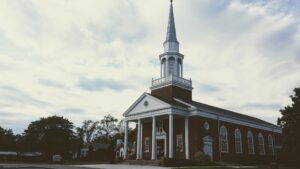Holly Run Church 1828-1911 When a small group of dissenters withdrew from the Patapsco Methodist Episcopal Church because of disagreements regarding lay representation, these Christians not only built a new church near Holly Run stream, but they also joined and helped found a new branch of Methodism -The Methodist Protestant Church. Following withdrawal from Patapsco M.E.C., a group of ladies, known as the Mite Society, met regularly at the home of Mrs. Hester Lucas. Worshipping with Mrs. Lucas were Mrs. Rezin Hammond, Mrs. Hezekiah Linthicum, Mrs. William Linthicum, Mrs. William Shipley, Mrs. Frank Thomas, and several others whose names are now unknown.
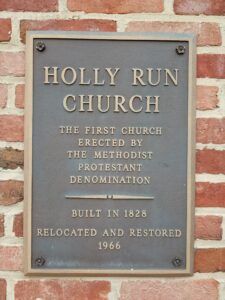 After three years of home meetings, both men and women became anxious to erect a church of their own. Thus, in 1828, a building made of recycled English brick was constructed on what is now the corner of Old Annapolis and Camp Meade Roads. Holly Run is thought to be the first new church built as a Methodist Protestant church. The three-quarter acre site, donated by Abner Linthicum, Jr., was deeded on November 30, 1831, to the origlnal Trustees, Basil L. Benson, Rezin Hammond, Richard Linthicum, William Shipley, John R. Thomas, and James R. Williams. Rev. William Bawden was the first pastor and served from 1829 until 1830. On December 10, 1831, the Associated Methodist Church of Holly Run in Anne Arundel County was Incorporated. The Brian, Benson, Hammond, Hawkins, Linthicum, Lucas Pumphrey, Shipley, Thomas, and Williams families were among the founders and early members of the Holly Run Church. Although many other families have been added to their number, descendants of these original families continue to be active members of the Linthicum Heights United Methodist Church.
After three years of home meetings, both men and women became anxious to erect a church of their own. Thus, in 1828, a building made of recycled English brick was constructed on what is now the corner of Old Annapolis and Camp Meade Roads. Holly Run is thought to be the first new church built as a Methodist Protestant church. The three-quarter acre site, donated by Abner Linthicum, Jr., was deeded on November 30, 1831, to the origlnal Trustees, Basil L. Benson, Rezin Hammond, Richard Linthicum, William Shipley, John R. Thomas, and James R. Williams. Rev. William Bawden was the first pastor and served from 1829 until 1830. On December 10, 1831, the Associated Methodist Church of Holly Run in Anne Arundel County was Incorporated. The Brian, Benson, Hammond, Hawkins, Linthicum, Lucas Pumphrey, Shipley, Thomas, and Williams families were among the founders and early members of the Holly Run Church. Although many other families have been added to their number, descendants of these original families continue to be active members of the Linthicum Heights United Methodist Church.The original Holly Run edifice measured twenty-seven feet in width and thirty-three feet in length. From this humble beginning, God worked through the members of this congregation in such a marvelous ways that Holly Run became the mother church of several Methodist churches, including those in Marley, Severn, Brooklyn, and Odenton, as well as Linthicum Heights.
During the pastorate of Rev, J. W. Gray in 1886, it was deemed necessary to construct an addition and redecorate the building. Mr. Sweetser Linthicum was chairman of this extensive project. The addition, which was approximately twenty-three feet long by twelve feet wide, included a basement and allowed ample room for a larger pulpit. The walls were exquisitely stenciled in a unique design created by an unknown German artist. Above the magnificent new stained leaded glass window the words “Holiness Becometh Thy House, O Lord” were inscribed. In the basement a stove was installed to heat coffee after the services so that the parishioners would be warmed before beginning their carriage rides home. The tradition of Coffee Hour continued a tradition established over one hundred years ago for many years in this congregation, though it is now called Discipleship and Donuts.
In 1891, Holly Run was recognized as an independent church and removed from the Anne Arundel Circuit. Even though Holly Run had flourished, by 1910, attendance and membership dwindled as the Linthicum Heights community was developing to the south of Holly Run’s original location at the corner of what is now Camp Meade and Old Annapolis Roads. In order to meet the needs of the community, the seven remaining Holly Run members determined that a new church must be erected. On December 3, 1911, the cornerstone for the new church was laid on the corner of Maple and Camp Meade Roads.
Also in 1911, the last regular service was held in the Holly Run Church. Mrs. Wade Hampton Linthicum waited with Rev. J. B. Jones until it was evident that no other worshippers would be arriving. Rev. Jones announced, “Sister, I’ll preach if you’ll sing.” Mrs. Linthicum played the organ and sang, and Rev. Jones preached an inspiring sermon. One chapter of our history had been written, but a new adventure in faith was beginning to unfold.
The “Stone Church” – 1911-1953 In reviewing the progress of our church from a small gathering of families at Holly Run Church to our present congregation of approximately one thousand members, the year 1911 is an important milestone. In that year the last regular worship service was conducted at Holly Run, the cornerstone for a new edifice was laid on the corner of Camp Meade and Maple Roads, and a new church, The Linthicum Heights Methodist Church, was recognized by the Maryland Conference.
The Port Deposit granite structure was constructed by Mr. Sweetser Linthicum, Jr., builder, in conjunction with Mr. Herbert G. Crisp, architect. The family of Mr. Sweetser Linthicum donated land for the project. The Linthicum Heights Company donated two lots on the corner of Camp Meade and Maple Roads. In addition to funds given by interested persons, $2000 was willed by Dr. Asa S. Linthicum for religious work in Anne Arundel County, and $500 was contributed by the Methodist Conference Church Extension Society.
The seven member building committee included Rev. John S. Bowers, Rev. George W. Haddaway, and Rev. Eugene C. Makosky, all of the Maryland Conference, as well as Rev. Arthur J. Torry, the minister of Nichols Memorial Church in Odenton, who assumed the additional responsibility of the Linthicum Heights pastorate. Mr. S.C. Pardee, Mr. Seth H. Linthicum, and Mr. William J. Grimm were the lay representatives.
On June 2,1912, Rev. Eugene C. Makosky, who was later to become pastor of this church, shared the principal address at the Service of Dedication. A regular worship service was held each week at 11:00 A.M., following Sunday School at 10:00 A.M.
When the granite building located at Maple and Camp Meade Roads was dedicated as the Linthicum Heights Methodist Protestant Church in 1912, the congregation was not yet large enough to warrant the appointment of a full time minister. Rev. Arthur J. Torry (1911-12), Rev. E.O. Ewing (1912-13) and Rev. Austin R. Middleton (1913-17) served our church as visiting ministers. In 1918, the Maryland Conference appointed Rev. E.H. Van Dyke as the first full time pastor or the Linthicum Heights congregation, which at that time included fifty-six members.
Although the church grew slowly at first, there were 125 members on the rolls by 1922. By 1929, the once spacious-granite edifice had become crowded. Modifications were made to the building. However, the growing congregation required more space, especially for its Sunday School. By 1950, Church School classes met in the Woman’s Club. Mrs. Wade H. Linthicum and Mrs. Alice Armiger hosted classes in their homes. Two more classes were annexed in the parsonage. As the need for space became even more acute, the Baltimore and Annapolis Railroad Station on Maple Road was utilized.
Although careful consideration was given to building an addition in order to alleviate the overcrowding, the congregation voted on March 9, 1950, to relocate. the church. Mr. Rollin Anderson, Mr. Earle Bauer, Mr. Henry Chiles, Mr. Luke Hill, and Mr. Raymond Shipley were designated to locate appropriate property. A Special Quarterly Conference, convened on December 20,1950, approved the committee’s recommendation to purchase 4.7 acres on School Lane from Mr. and Mrs. Wengert at a cost of $25,000. Since the Wengerts and the Conference Board of Missions each contributed $5,000, the total cost to the congregation was $15,000. Ground was broken for the Marion Jamieson Memorial Building of the Linthicum Heights Methodist Church on March 15,1953.
God again had given the Linthicum Heights congregation a vision of growth within our community and the faith to embark upon this new adventure.
On July 5, 1953, the cornerstone was laid for the first section of the Linthicum Heights Methodist Church to be built at our present location. This construction Included the chapel (now Fellowship Hall) and west wing of our educational building. Known as the Marlon H. Jamieson Building of the Linthicum Heights Methodist Church, the building was named In honor of Mrs. Marion Jamieson who, since moving to Linthicum with her husband in 1926, was a dedicated and active member of our congregation and Sunday School Superintendent for many years.
Built by the Lawrence Construction Company at a cost of $157,843, the new building was ready for its first service on December 20, 1953. Rev. Norman L. Trott, D.D., Superintendent of the Baltimore South District, shared the morning message. While hanging a wreath over the chapel door the night before the service, Rev. Walter. H. Stone, pastor of Linthicum Heights from 1951-1962, fell and broke his ankle. Although Rev. Stone was unable to attend the first service, Mr. Raymond Shipley assisted Rev. Trott. Muslc for the service was provided by Mrs. Helen Haslup, organist, and Mrs. Harry Heins, choir director. In 1953, approximately 150 children, ranging from nursery age through elementary school age, were enrolled In our church school. On December 16, 1973, a service following the same Order of Worship commemorated the first service held in the Marion H. Jamieson Building.
In 1954, a colonial style home for the pastor was constructed by Mr. Raymond T. Neighoff, contractor, at a cost of $20,600. We now refer to this home as parsonage one.
Also In 1954, the Diocese of Maryland purchased our former parsonage and granite church building, located at the corner of Maple and Camp Meade Roads. The congregation of St. Christopher’s Episcopal Church met in this building for many years. It is now the home to Holy Cross Antiochian Orthodox Church.
In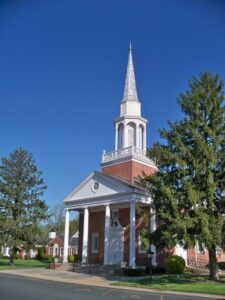 December, 1957, the Marion H. Jamieson Building was dedicated free of debt. Less than one year later, on November 9, 1958, ground was broken on the east side of Jamieson Building for the second and third units. Included were a sanctuary to seat six hundred people, additional educational space (13 classrooms), and offices for the minister and church secretary. Also, at that time an addition to the kitchen was made. The sanctuary’s 105-foot steeple contains the 15-bell Linthicum Carillon, the gift of the late Mr. J. Charles Linthicum, in memory of his wife.
December, 1957, the Marion H. Jamieson Building was dedicated free of debt. Less than one year later, on November 9, 1958, ground was broken on the east side of Jamieson Building for the second and third units. Included were a sanctuary to seat six hundred people, additional educational space (13 classrooms), and offices for the minister and church secretary. Also, at that time an addition to the kitchen was made. The sanctuary’s 105-foot steeple contains the 15-bell Linthicum Carillon, the gift of the late Mr. J. Charles Linthicum, in memory of his wife.
 December, 1957, the Marion H. Jamieson Building was dedicated free of debt. Less than one year later, on November 9, 1958, ground was broken on the east side of Jamieson Building for the second and third units. Included were a sanctuary to seat six hundred people, additional educational space (13 classrooms), and offices for the minister and church secretary. Also, at that time an addition to the kitchen was made. The sanctuary’s 105-foot steeple contains the 15-bell Linthicum Carillon, the gift of the late Mr. J. Charles Linthicum, in memory of his wife.
December, 1957, the Marion H. Jamieson Building was dedicated free of debt. Less than one year later, on November 9, 1958, ground was broken on the east side of Jamieson Building for the second and third units. Included were a sanctuary to seat six hundred people, additional educational space (13 classrooms), and offices for the minister and church secretary. Also, at that time an addition to the kitchen was made. The sanctuary’s 105-foot steeple contains the 15-bell Linthicum Carillon, the gift of the late Mr. J. Charles Linthicum, in memory of his wife.The contract for $305,464 was awarded to The M. L. Robertson Sons Company. The Building Committee for this unit consisted of Mr. Ray C. Shipley, chairman, Mr. Rollin Anderson, Mrs. Charles Caskey, Mr. J. Franklin Diggs, Mr. Seth H. Linthicum, Mr. Leonard Sauerhammer, and Mrs. Kenneth Sheppard.
The cornerstone was laid on May 24,1959, with many former ministers and friends in attendance. The first service was held in the main sanctuary on April 24, 1960. The Reverend Merritt Dietterich, D.D., and The Reverend Robert Parker, D.D. were special guests. The Reverend William E. Keese, D.D., Minister of Grace Methodist Church, spoke in the evening. Approximately one thousand people attended services on that memorable day.
As the congregation continued to grow, a second parsonage was built on the property in 1961 to house an Associate Pastor.
Reclaiming Holly Run After the closing of Holly Run for regular services, pilgrimages were held each year usually in September under the auspices of the Linthicum Heights Methodist Protestant Church. In the 1920’s there was a morning service at 11:00 A.M. and an afternoon service at 3:00 P.M. with recess and lunch from picnic baskets. These pilgrimages were abandoned during the war years, but were resumed in 1945 and continued for 6 years under Rev. Benson, and 2 years under Rev. Walter H. Stone. As time went by and old members died or moved away, pilgrimages were discontinued. The building was then deemed unsafe in 1953 and was boarded up. Vandalism however became so bad and constant that it became impossible to keep the premises secure, and restoration at the old site of the church was deemed impossible.
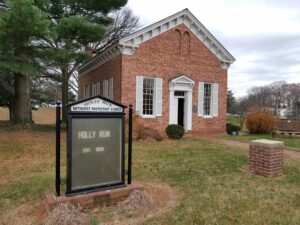 During the ministry of Rev. Walter H. Stone, it was decided to relocate Holly Run Church to the present grounds of the new Linthicum Heights Methodist Church on School Lane, if and when, this project became possible in order to preserve this old church as a shrine to Methodism.
During the ministry of Rev. Walter H. Stone, it was decided to relocate Holly Run Church to the present grounds of the new Linthicum Heights Methodist Church on School Lane, if and when, this project became possible in order to preserve this old church as a shrine to Methodism.In 1966, during the ministry of Rev. William C. Durrett, the dream to relocate and restore Holly Run Church became a reality. The site of the old church was sold. The money derived from the sale made it possible to accomplish this project. About this time, Rev. Durrett was called to another charge and Rev. Harold Bell Wright became minister.
In 1967, during Rev. Wright’s ministry, the project of relocating and restoring Holly Run Church was completed. The old structure was dismantled brick by brick and was re-erected and restored at its new location on the church grounds. All of the old bricks and much of the timber, woodwork and hardware were used. The original pulpit, stove, altar rails and some of the old pews were found and installed. Much of the research and locating of these old furnishings was done by Mrs. Laura Shipley Roberts. Experts, as well as members and residents who formerly attended Holly Run Church, all agreed that it is an exact replica and indeed the same old Holly Run Church only at a new location. The committee for the restoration of Holly Run Church consisted of Rev. William C. Durrett, Rev. Harold B. Wright, Mr. Richard Shipley, Mr. Curtiss Garrett, Mr. Clarence Disney, Dr. C. D. Caskey, Mrs. Laura Shipley Roberts, Dr. Charles Milton Linthicum, Mr. Raymond C. Shipley, Mr. Seth H. Linthicum, Mr. Ellsworth E. Nowell, Mr. Leonard Sauerhammer, Mr. Kenneth Carr, Mr. Rollin M. Anderson, and Mr. Sweetser Linthicum, Chairman. Mr. Raymond C. Shipley was in charge of the actual dismantling and reconstruction during re-location and restoration. Unfortunately Mr. Ellsworth E. Nowell and Mr. Seth H. Linthicum departed this life before restoration was completed.
A copper plaque with an embossed picture of Holly Run and an inscription commemorating the spirit and memory of those who built the church now marks the spot where the church once stood. A special service was held on September 30, 1967 to install the plaque on a gas station which now stands on the original location. The opening prayer was given by Rev. Joseph Clark, Pastor of St. Christophers Episcopal Church. Mrs. John G. Chappel, past governor of the national organization of the Sons & Daughters of the Pilgrims, read the dedication address. The benediction was given by the Rev. Harold Bell Wright, Pastor of The Linthicum Heights Methodist Church.
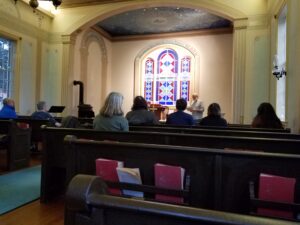 When Holly Run was relocated, the reconstructed interior walls were of white plaster, lacking the stenciling added in 1886. Under the leadership of Mrs. Laura Roberts, money was raised to restore the white interior walls to their stenciled glory. In 1978 as part of the church’s sesquicentennial celebration, the interior stenciling was recreated by Ronald Spencer, a Baltimore artist.
When Holly Run was relocated, the reconstructed interior walls were of white plaster, lacking the stenciling added in 1886. Under the leadership of Mrs. Laura Roberts, money was raised to restore the white interior walls to their stenciled glory. In 1978 as part of the church’s sesquicentennial celebration, the interior stenciling was recreated by Ronald Spencer, a Baltimore artist.In 2004, Holly Run was struck by lightening causing a fire in the roof that spread to the ceiling of the church. Thanks to the quick response of the Anne Arundel County Fire Department, little of the structure was damaged. However, the water used to fight the fire ruined the interior plaster of the church including the extensive stenciling added in 1978. Within days, Ronald Spencer, the artist who had done the recreation of the stenciling contacted the church and offered to work on the restoration. The church has now been completely restored.
Holly Run is now used for special services including weddings, baptisms.
Linthicum Heights United Methodist Church Today
Linthicum Heights United Methodist Church remains an active and vibrant community of faith with ministries in the Linthicum Heights community, the Baltimore area, the Baltimore Washington Conference, and throughout the world.
The Formation of the Community Parrish 2022
Pastors of Holly Run
| 1829-1830 | William Bawden |
| 1830 | William Sexsmith |
| 1831 | William Kelsey Hays, Assistant |
| 1832 | Hauser |
| 1834 | Dan Davis |
| 1836-1837 | Elijah Henkle |
| A. A. Lipscomb, Assistant | |
| 1838 | P. E. Resne |
| 1839 | Dan Davis |
| 1839 | Hale |
| 1842-1843 | Appleby |
| William Sexsmith, Assistant | |
| 1844 | Norwood |
| 1845 | Thomas Whiteworth |
| David Wilson, Assistant | |
| 1846-1848 | R. S. Norris |
| 1846 | J. M. Henkle, Assistant |
| 1847 | Oliver Cox, Assistant |
| 1848 | J. D. Brooks, Assistant |
| 1849 | W. C. Poole |
| 1850-1851 | H. J. Day |
| 1852-1853 | John Elderdice |
| 1854 | R. T. Boyd |
| 1855-1856 | W. S. Hammond |
| 1857-1859 | E. F. Ewell |
| 1859-1860 | J. M. Everist |
| E. F. Ewell, Assistant | |
| 1861-1862 | D. W. Bates |
| 1863-1864 | J. M. Elderdice |
| C. F. Cochel, Assistant | |
| 1865-1868 | C. H. Littleton |
| 1869-1874 | J. W. Gray |
| 1873 | J. G. Sullivan, Assistant |
| 1874 | J. B. Butler, Assistant |
| 1875-1876 | A. D. Dick |
| 1875 | D. C. Gilbert, Assistant |
| 1876 | J. D. McFaden, Assistant |
| 1877-1879 | D. A. Schomer |
| 1880 | J. T. Lassel |
| 1880 | G. H. McFaden |
| 1881-1884 | W. J. Floyd |
| 1881 | E. W. Starr, Assistant |
| 1882 | W. F. Roberts, Assistant |
| 1884 | S. F. Cassen, Assistant |
| 1885 | J. B. Jones |
| 1886-1890 | J. W. Gray |
| 1886 | J. F. Wooden, Assistant |
| 1887-1890 | J. R. Nichols, Assistant |
| 1891 | E. B. Taylor |
| 1892-1893 | G. R. Donaldson |
| 1894 | J. G. Sullivan |
| 1895 | G. L. Schlinke |
| 1896-1897 | J. F. Wooden |
| 1898-1900 | G. R. Hodge |
| 1909 | C. R. Strausburg |
| 1910-1911 | J. B. Jones |
Pastors of Linthicum Heights Church
| 1911-1912 | Arthur J. Torry |
| 1912-1913 | E. O. Ewing |
| 1913-1917 | Austin R. Middleton |
| 1919-1921 | E. H. Van Dyke (First full-time pastor) |
| 1921-1923 | Bradley Wilson Kindley |
| 1923-1925 | Edward T. Kirkley |
| 1925-1928 | Louis Randall |
| 1928-1930 | Luther F. Warner |
| 1930-1931 | Paul F. Warner |
| 1931-1935 | Eugene C. Makosky |
| 1935-1941 | W. A. Roberts |
| 1941-1945 | C. C. Knapp |
| 1945-1951 | J. E. Benson |
| 1951-1962 | Walter H. Stone |
| 1960-1961 | Thomas Carrick, Associate Pastor |
| 1961-1964 | Ray E. Clements, Associate Pastor |
| 1962-1966 | William C. Durrett |
| 1964-1970 | Robert A. McLaughlin, Minister of Education |
| 1966-1981 | Harold Bell Wright |
| 1968-1972 | Ralph W. Watt, Minister of Visitation |
| 1971-1973 | Virginia Wilson, Director of Religious Education |
| 1973-1977 | Kenneth R. Dunnington, Associate Pastor |
| 1977-1979 | Richard Hogue, Associate Pastor |
| 1981-1993 | Donald Llewellyn |
| 1981-1983 | Dennis DeBoy, Associate Pastor |
| 1983-1990 | Reg Barss, Associate Pastor |
| 1990-1992 | Christian DeLaRosa, Associate Pastor |
| 1992-2002 | Sharon Ford, Associate Pastor |
| 1993-1996 | Frederick Crider |
| 1996-1999 | Timothy Dissmeyer |
| 1999-2018 | David A. Shank |
| 2003-2007 |
Stacey Cole Wilson, Associate Pastor
|
